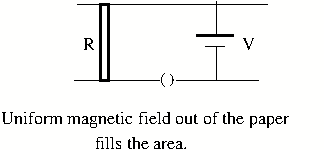|
|
[NOTES/EM-01002]- Thomson’s Method for e/mNode id: 5506pageThomson passed electrons through a region having mutually perpendicular electric and magnetic field, and both perpendicular to the velocity of the electrons. The fields were adjusted so as to produce no deflection. This enebled him to measure the \(e/m\) of electrons.
|

|
22-11-17 18:11:52 |
n |
|
|
[SUNDAY-PHYSICS] GATE/JEST/NET Hint for Solutions of Complex Variables QuestionsNode id: 5772page |

|
22-11-06 08:11:48 |
n |
|
|
Sunday PhysicsNode id: 3462forum |

|
22-11-06 06:11:41 |
|
|
|
[MCQ/CV-02001] Analytic functionsNode id: 5796page
If \(f(z)\) is an analytic function of \(z\), \(\left( \frac{\partial^2 }{\partial x^2} + \frac{\partial^2 }{\partial y^2}\right) \left| f(z)\right|^2\) is equal to
| (A) \(2 \big| f^ \prime(z)\big|^2\) |
(B) \(3 \big|f^\prime(z)\big|^2\) |
| (C) \(4 \big| f^\prime(z)\big|^2\) |
(D) \(8 \big| f^\prime(z)\big|^2\)
|
Select a simple analytic function and test which option is correct.
Take \(f(z)=z\) and then it is easy to check that Option (C) is the correct option.
With choice \(f(z)=z\), we get \( \big|f(z)\big|^2 = (x^2+y^2)\).
Therefore
\(\left( \frac{\partial^2 }{\partial x^2} + \frac{\partial^2 }{\partial y^2}\right) \left| f(z)\right|^2 = 4\)
Also we have \(f^\prime(z)=1\).
Hence Option (D) is the correct option.
Communicated by Sunday-Physics-Participant
|

|
22-10-21 15:10:26 |
n |
|
|
[PSU/CV-02001] Solution of Equations in Complex Plane --- Solution of EquationsNode id: 5794page |

|
22-10-20 12:10:23 |
n |
|
|
[QUIZ/EM-04001] A charge and two infinite planesNode id: 2992page |

|
22-10-18 11:10:04 |
n |
|
|
[QUIZ/EM-04002] A thick spherical shell and a point chargeNode id: 2991page |

|
22-10-18 11:10:30 |
n |
|
|
[QUIZ/EM-09001] Electromagnetic InductionNode id: 3022page
|
A rod of mass $m$ and length $\ell$ and resistance $R$ rests and is free to slide on two parallel rails of zero resistance as shown in \Figref{em-fig-09008}. A uniform magnetic field fills the area surrounding the rails and is perpendicular and out of the plane of the paper. A battery of of voltage $V$ is connected as shown in the figure.
|
 |
- Qualitatively describe the motion of the rod when the circuit is completed by closing the key.
- How the motion will change if the connection of the battery polarity is reversed magnetic field remains the same?
- How the motion will change if the direction of the magnetic field is reversed and the battery is connected as shown?
|
|

|
22-10-18 11:10:54 |
n |
|
|
[QUIZ/EM-01001] Equal Point Charges on Corners of a Regular PolygonNode id: 5792page Equal charges \(Q\) are placed on corners of a regular polygon. Show that the electric field at the center of polygon is zero. Use only geometrical arguments. Do not write any expressions or equations.
You may write a small paragraph or draw a figure. \\
The proof is easy for a polygon of even number of sides. How about the case charges on a regular polygon of odd number of sides?
Sketch figures to indicate a proof for a regular pentagon.
|

|
22-10-18 11:10:17 |
n |
|
|
[QUE/TH-01004] TH-PROBLEMNode id: 5189page
Express the temperatures given below in $^\circ C,R$, and $^\circ F$. Write your answers in form of table.
- (a) Triple point of Hydrogen 13.81 K
- (b) Boiling point of Ne 27.102 K
- (c) Boiling point of Oxygen 90.188 K
- (d) Melting point of zinc 692.664
- (e) Melting point of gold 1337.58
| SN |
K |
C |
F |
R |
| (a) |
|
|
|
|
| (b) |
|
|
|
|
| (c) |
|
|
|
|
| (d) |
|
|
|
|
| (e) |
|
|
|
|
|

|
22-10-17 15:10:45 |
n |
|
|
SUNDAY-PHYSICS Challenge Problem-02Node id: 5787page |

|
22-10-17 13:10:27 |
n |
|
|
[SUNDAY-PHYSICS/CV-LEC-01] Notes for Session-01 --- When is a Function Analytic ?Node id: 5608pageNOTES FOR Session-01 Jul 17, 2022
|

|
22-10-16 19:10:31 |
n |
|
|
Let's Discuss The Postulates :: Consistency of Probability InterpretationNode id: 4834basic_multi_step |

|
22-10-08 12:10:10 |
n |
|
|
Sunday-Physics Challenge Problem-001Node id: 5783pageEqual charges \(Q\) are placed on corners of a regular polygon. Show that the electric field at the center of polygon is zero.
This problem is easy to solve by summing over electric field due to individual charges and using trigonometric identities, or something equivalent.
The challenge is to find simpler solution without writing any expressions, or equations, without using any complicated identities. Simply sketch a diagram to indicate a proof for a regular pentagon.
|

|
22-10-03 07:10:25 |
n |
|
|
SUNDAY-PHYSICS :: Challenge ProblemsNode id: 5782collectionEqual charges on a regular polygon
|

|
22-10-03 07:10:33 |
n |
|
|
SUNDAY PHYSICS --- Lecture 11 , Sept 18, 2022Node id: 5781page |

|
22-10-03 04:10:34 |
n |
|
|
SUNDAY-PHYSICS October 3, 2022 Lecture 12 Node id: 5780page |

|
22-10-03 04:10:30 |
n |
|
|
REVQ/EM-03001 Review Questions ---- Sample to Test IdeasNode id: 5777page |

|
22-09-28 05:09:48 |
n |
|
|
[AGBX/EM] Anti Gray Boxes --- Electromagnetic TheoryNode id: 5397page |

|
22-09-27 23:09:44 |
n |
|
|
How to Use the Drawing ToolNode id: 563page |

|
22-09-26 19:09:41 |
n |